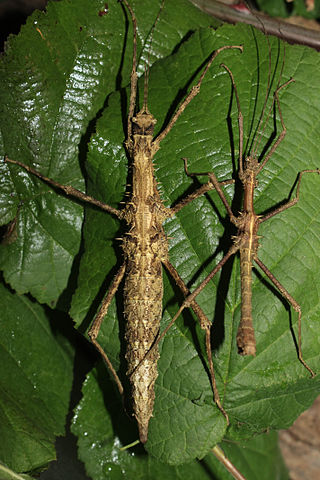
The grasshopper subfamily Acridinae, sometimes called silent slant-faced grasshoppers, belong of the large family Acrididae in the Orthoptera: Caelifera.

Conocephalus is a genus of bush crickets, known as coneheads. It was described by Carl Peter Thunberg in 1815.

The Melanoplinae are a subfamily of grasshoppers in the family Acrididae. They are distributed across the Holarctic and Neotropical realms. They are one of the two largest subfamilies in the Acrididae. As of 2001 the Melanoplinae contained over 800 species in over 100 genera, with more species being described continuously.

Supella is a genus of cosmopolitan and wild cockroaches, in the family Ectobiidae: originating from Africa and the Arabian Peninsula.

Gryllacrididae are a family of non-jumping insects in the suborder Ensifera occurring worldwide, known commonly as leaf-rolling crickets or raspy crickets. The family historically has been broadly defined to include what are presently several other families, such as Stenopelmatidae and Rhaphidophoridae, now considered separate. As presently defined, the family contains two subfamilies: Gryllacridinae and Hyperbaeninae. They are commonly wingless and nocturnal. In the daytime, most species rest in shelters made from folded leaves sewn with silk. Some species use silk to burrow in sand, earth or wood. Raspy crickets evolved the ability to produce silk independently from other insects, but their silk has many convergent features to silkworm silk, being made of long, repetitive proteins with an extended beta-sheet structure.

Hemimerus is a genus of earwigs, in the family Hemimeridae. It is one of two genera in the family of Hemimeridae, and contains ten species:

The Phaneropterinae, the sickle-bearing bush crickets or leaf katydids, are a subfamily of insects within the family Tettigoniidae. Nearly 2,060 species in 85 genera throughout the world are known. They are also known as false katydids or round-headed katydids.

Ectobius is a genus of non-cosmopolitan cockroaches once thought native to the Old World and described by Stephens in 1835, belonging to the family Ectobiidae, subfamily Ectobiinae. The discovery of 4 ectobius cockroaches in Colorado dating to 49 Million years ago suggests the genus actually originated in North America. This genus has been subject to a number of revisions.

Eumastacoidea is a superfamily within the order Orthoptera, suborder Caelifera. The family has a mainly tropical distribution and have sometimes been called "monkey grasshoppers".

Orchelimum is a genus of katydid with 21 known species.

The Tanaoceridae are an insect family in the monotypic superfamily Tanaoceroidea in the suborder Caelifera. They are sometimes called desert long-horned grasshoppers.

The Heteropterygidae is a family of stick insects belonging to the suborder Euphasmatodea. Species can be found in Australasia, East and Southeast Asia. More than 130 valid species have been described.

The Obriminae are the most species-rich subfamily of the Phasmatodea family Heteropterygidae native to Southeast Asia. It is divided into two tribe.

Datamini is the only tribe within the subfamily of the Dataminae from the order of the Phasmatodea. The representatives of this subfamily are on average not as large as those of the other two subfamilies belonging to the family of Heteropterygidae.
Keyacris is a genus of grasshoppers belonging to the family Morabidae.

The genus Tisamenus native to the Philippines combines small to medium-sized species of stick insects.

Brasidas is a genus that is native to the Philippines and is named after the Spartan general Brasidas

Obrimus is a stick insect genus native to the Philippines. It is type genus for the tribe and the subfamily in which it is listed.

Heterocopus is a monotypic stick insect genus, containing Heterocopus leprosus as the only valid species.

The genus Euobrimus is a Philippines-native stick insect genus that is very similar or synonymous with the genus Brasidas.


















